Designing Ventilation Systems and Selecting Diffusers
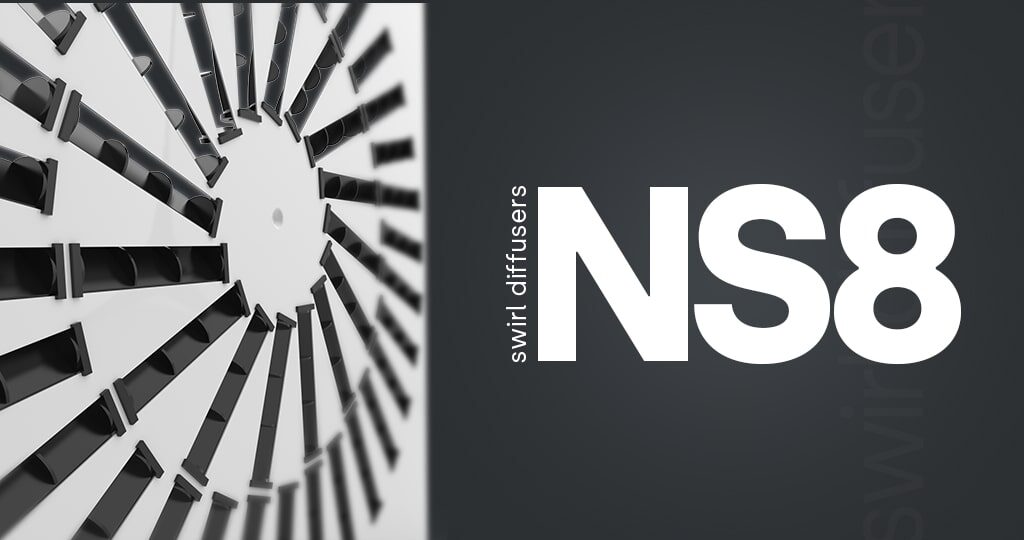
Diffusers are ones of the most important elements of any ventilation and air-conditioning system. Regardless of the type of a system they have a decisive influence on the distribution of airflow velocity and air temperature in a room. The main task of diffusers is to supply required airflow rate to rooms. If we take care of right parameters, we can ensure comfortable conditions in a zone occupied by people, which means no draught, low level of noise and thermal comfort. These factors have a great impact on people’s feeling of tiredness during long-lasting occupation of a room, and therefore the correct concept of air distribution in the room and determining the right number of devices, their types and working parameters, are so important.
SMAY offers many types of diffusers, which are suitable for using in almost all kinds of buildings of various destination. The wide selection of these products makes it possible to meet many project requirements, and hence — to design the system properly.
Linear diffusers
These diffusers are usually being installed in open space offices, along the walls. Their width is small in comparison with their length. These devices are suitable for using both for air supply and air exhaust in rooms. They are used for supplying isothermal air, as well as in situations when there is the temperature difference between the supplied air and air in the room. These devices are used both in heating and cooling modes.
Depending on the type of the diffuser, the slots may be movable or fixed. The number of slots may differ as well. The design and number of slots have an impact on the working parameters of a diffuser. For the heating function, in order to provide the comfort feeling in the occupied zone and to use the energy of inflowing warm air as well as possible, the slots should direct the flow downwards. In case of room cooling, the vanes should be set horizontally and distribute the air under the ceiling using the Coanda effect — in order to provide optimal coverage and prevent cold (denser) air from falling down too fast into the zone occupied by people.
If the diffusers are installed in line with windows, due to the functionality of directing airflow individually for each slot, it is possible to direct airflow for the part of the slot towards the window. It makes it possible to create an “air curtain” on the level of the window, and hence to receive gain/loss from these dividers efficiently.
NSAL
An aluminium ceiling slot diffuser with movable vanes, which can operate both in heating and cooling mode. A single diffuser may be up to 2000 mm long and have from one to six slots. NSAL diffusers may be installed as single elements or sets connected in line; they may be painted in any RAL colour. This diffuser may be installed by means of a mounting console, to ceiling with screws inserted from the front, or directly to a plenum box. SMAY’s diffuser selection program makes it possible to determine working parameters for different lamella configurations — they are presented schematically in the figure below.
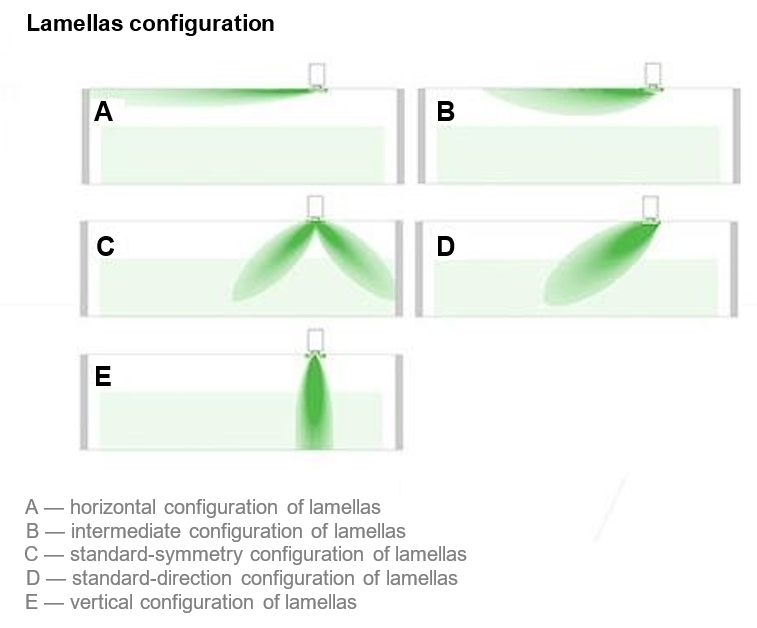
NSAL-N
An aluminium slot diffuser designed for systems with constant and variable airflow rate. These diffusers can operate both in heating and cooling modes. The diffusers have movable, profiled vanes. It makes it possible to change the slot covering or to direct the airflow. These diffusers can have from one to five slots. The diffusers may be installed as single elements or sets connected in line. The design of the diffuser makes it possible to direct the air flowing out of the device either vertically or horizontally, as shown in the drawing.

Swirl diffusers
Swirl diffusers are used for air supply in office rooms, shopping malls, schools, public utilities, as well as industrial and living premises. Depending on the model, the diffusers make it possible to adjust of the vane angle, and hence to control the direction of air supply. The high level of air induction in the swirl diffusers makes it possible to mix air in a room efficiently. These devices can work both in heating and cooling mode. In SMAY’s offer there are following devices:
NS8
These diffusers are particularly recommended for the rooms from 2.6 m to 4 m high. They are also worth taking into consideration if the temperature difference between the supply air and air in a room is up to 10 K. NS8 diffusers are available with circular or rectangular front panel. The rectangular panel may be made of stainless steel. Movable vanes make it possible to form the supply air flow freely and to obtain the swirl air supply. In the figure below there are shown different versions of configuration of diffuser vanes. It may also be seen how the configuration translates into the direction of the outflow of air from the device.
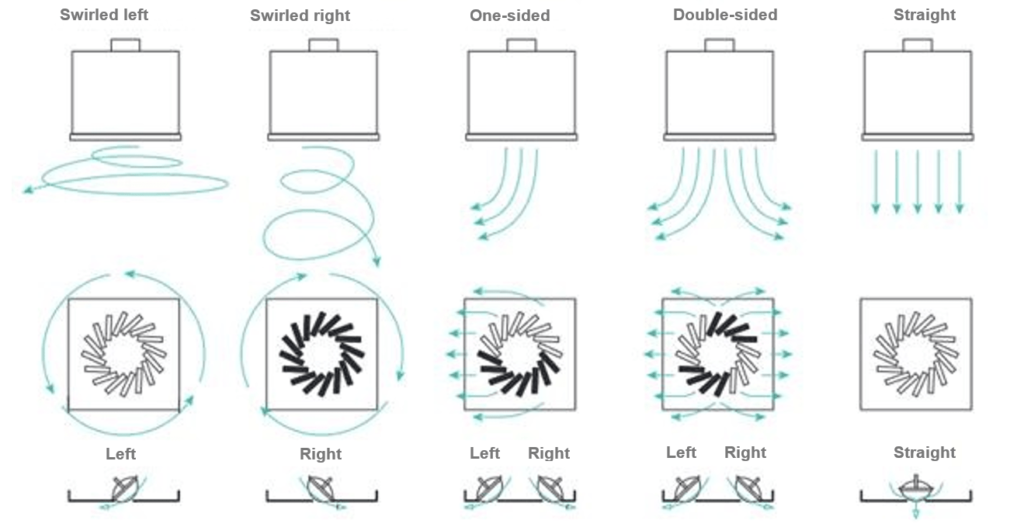
NS9
These diffusers are particularly recommended for rooms from 2.6 m to 4 m high. They are also worth taking into consideration if the temperature difference between the supply air and air in the room is up to 10 K. The diffusers are available with circular or rectangular front panel. The rectangular panel may be made of stainless steel. Movable vanes make it possible to form the supply air flow freely and to obtain the swirl air supply. In the figure below there are shown different versions of configuration of diffuser vanes. It may also be seen how the configuration translates into the direction of the outflow of air from the device.
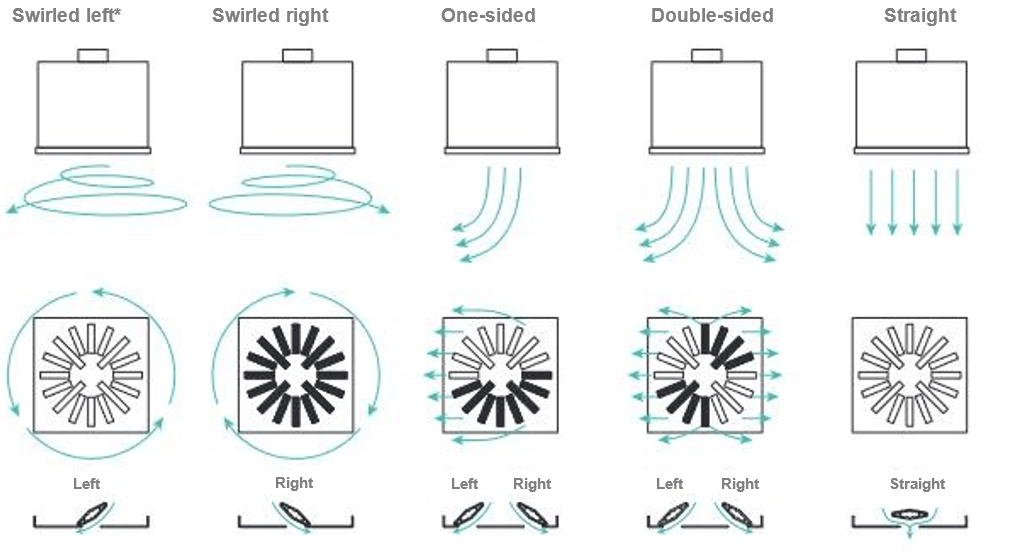
NS4
NS4 diffusers are equipped with fixed vanes that generate swirl air flow. The front panel of the diffuser may be round or square. By default, the device is made of steel, powder-coated in RAL 9010. On special request they may also be coated with other RAL colours.
NS4 diffusers may be made in a supply version (a plenum box with a deflector) or in an exhaust version (a plenum box without a deflector). There are also two available versions — standard and horizontal. The difference in versions translates, among other things, into different directions of air flowing out of the diffuser. By using SMAY’s diffuser selection program it is possible to determine working parameters for both design versions. If the device is to operate in the heating or exhaust mode, we recommend the standard version.
NSDZ
NSDZ diffusers make it possible to obtain swirl air supply. They perform particularly well in rooms from 3 m to 12 m high, where heating and cooling is being provided by a ventilation system, or where precise settings of the supply airflow final velocity in a zone occupied by people is a crucial parameter. The configuration of vanes translates into the direction of air flowing out of the diffuser, as shown in the diagram below.
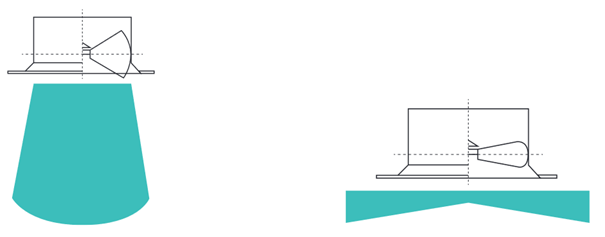
Two versions of vane control are being used in NSDZ diffusers: manual and with an actuator. During manual regulation the position of mutually integrated vanes is being changed manually by means of a lever situated on the outer side of the diffuser body. During regulation with an actuator, the position is set by means of an electric actuator working in a continuous setpoint mode, supplied with 24 V AC/DC or 230 V AC. In this control mode the vanes may be set in any position.
Ceiling diffusers
Ceiling diffusers are supply or exhaust elements designed for installation in a ceiling. Depending on the type and shape, they make it possible to direct the air flowing out of the diffuser in different directions. Additionally, ceiling diffusers make it possible to guide airflows in several directions — depending on the construction, in one, two, three, or four directions. Ceiling diffusers are being used in mechanical ventilation systems. Among them there are diffusers with the rectangular or circular panel. SMAY offers the following devices of this type:
ALDA/SDA
ALDA diffusers are made of aluminium anodised in natural colour or powder-coated in white (RAL 9010). On request, they may also be coated in other RAL colour. SDA diffusers are available with a rectangular panel. They are made of steel powder-coated in white (RAL 9010). Other RAL colour painting and a stainless steel version are available to special order. ALDA and SDA ceiling diffusers are available with vanes adjusted to uni-, bi-, tri-, or quad-directional flow.
SDRW
SDRW ceiling diffusers are available with a circular panel. They are designed for public and industrial premises. They have the following distinctive feature: the position of their vanes is being changed by rotation of the central part of the diffuser, which makes it possible to shape the supply airflow individually. Round movable vanes are being set by means of a manual mechanism. This diffuser is suitable both for heating and cooling.
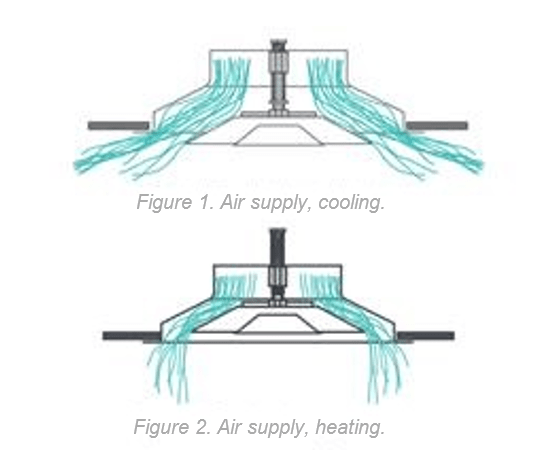
NT/NTQ
NT and NTQ ceiling diffusers are designed for using in low- and medium-pressure ventilation systems in public and industrial premises. Adjustable vanes, which make it possible to shape the supply airflow individually, are the distinctive feature of these devices. The diffusers have round movable vanes, being set by means of a thermostatic actuator. NT diffuser is fitted with a circular panel, and NTQ diffuser — with a rectangular panel.
NSP floor slot diffusers
NSP floor slot diffusers are mainly designed for installation in swimming pool halls, and in rooms, where there are large glazed surfaces. They are usually mounted near glazed surfaces, in the floor or even in windowsills. With such an installation, the diffusers ensure airflow on glazed surfaces, which prevents them from fogging and sweating.
Long-range nozzles
They are being used for supplying ventilation air in high-volume rooms or in interiors, where it is not possible to distribute the system freely, and there is a need to supply air over a great distance (for example, to the opposite part of the room). It is possible to change the air outflow angle in the nozzles, which makes it possible to direct the airflow, and is also helpful in execution of heating or cooling functions.
For the cooling mode it is possible to set the nozzle at a positive angle (depending on the type of the nozzle the angle may be set up to +30°) — it directs the airflow towards the ceiling. Since there is supplied cool air, which has higher density, when the distance gets greater, the stream begins to fall down, whereas in most cases the goal is to prevent the airflow from falling down near the nozzle.
For the heating mode it is possible to set the nozzle at a negative angle (depending on the type of the nozzle the angle may be set up to -30°). In this situation the airflow is being directed downwards. Since there is supplied warm air, which has lower density, and the buoyant force interacts, when the air reaches the zones occupied by people, the temperature and velocity are reduced. SMAY’s offer includes the following products from this group:
SVS5
SVS5 nozzles are available in five sizes. It is adapted for installing directly on a rectangular duct, by means of the R type cover plate on a circular duct also, and by means of the RF adapter for installation at the end of a circular duct. The angle of the air outflow in SVS5 can be set manually or by means of an electric actuator, within the range of ±30°.
SVS6
SVS6 aluminium nozzles are available in six sizes. It is adapted for installing directly on a rectangular duct, by means of the R type cover plate on a circular duct also, and by means of the RF adapter for installation at the end of a circular duct. The angle of the air outflow in SVS6 may be set manually, within the range of ±30°.
SVS7
SVS7 aluminium nozzles are available in four sizes. It is adapted for installing directly on a rectangular duct, by means of the R type cover plate on a circular duct also, and by means of the RF adapter for installation at the end of a circular duct. The angle of the air outflow in SVS7 may be set manually, within the range of ±30°. This nozzle includes a swirling element.
SVN
SVN nozzles are available in six sizes. It is adapted for installing directly on a rectangular duct or at the end of a circular duct. The angle of the air outflow in these nozzles may be set manually within the range of ±30°.
Author

Michał Golonka
Product Manager – Constructor: Diffusers



